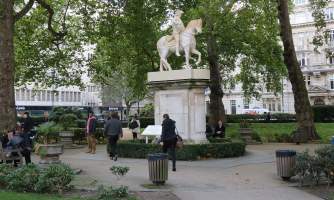 Cavendish Square, with central statue emplaced.
Cavendish Square, with central statue emplaced.
 Cavendish Square, with central statue emplaced.
Cavendish Square, with central statue emplaced.
Not at all the usual sort of thing to be found on this website, but here we have a statue in soap of the Duke of Cumberland, put up in the centre of Cavendish Square behind John Lewis on Oxford Street in July 2012, and intended to decay slowly over time before removal after one year. It is the work of Meekyoung Shin, a Korean artist, who on the basis of a scan of various web sources, is based in Seoul and London, was born in 1967, and studied at the National University in Seoul, and at the Slade; soap appears to be her medium of choice.
As noted on the plaque by the statue, there was a statue of the Duke of Cumberland in the square, put up in 1770, and removed in 1868, and it is the plinth of that original statue which is being used for the replica. How much resemblance does it bear to the original? The original was apparently melted down on removal, by order of the 5th Duke of Portland, however web sources refer to the soap statue being modelled from prints and engravings of the original. I have not seen an engraving, but there is a small version of the original in the V&A, which can be viewed on their site, and on the basis of this, the soap statue catches the pose, within the limits of the material and some variation in the detail. Putting aside any consideration of how far the statue stands up to close examination, the reason to note it on this website, with its focus on historic sculpture, is because walking into the square, how fitting it is that there is a statue in the middle of it. All credit to Meekyoung Shin, Arts Council England and Arts Council Korea, together with the other sponsoring organisations, in allowing us to see the square how it should look.
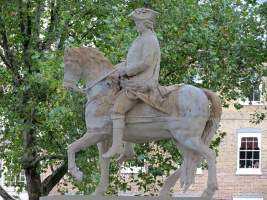
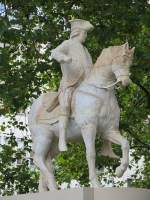
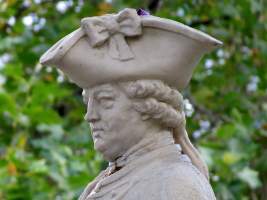 Two views of Meekyoung Shin's soap statue, and detail.
Two views of Meekyoung Shin's soap statue, and detail.
A few words on the original statue. It was the work of Sir Henry Cheere Bt (1703-81), a significant sculptor of the 18th Century, often confused in the literature with his sculptor brother, John Cheere (1709-87); it is possible that John collaborated with Henry on this piece, as while John's own work is not so ambitious, his speciality was lead sculpture. While the Duke of Cumberland statue was melted down, examples of his other work may be seen in Westminster Abbey and elsewhere. A particularly splendid example of his work is the monument to Bishop Richard Willis, d.1734, in Winchester Cathedral, with a reclining or rather lounging figure of the subject gazing in rapture at his own coat of arms; a representation of insouciance. The Cavendish Square monument was made of lead, common as a material for public statues in those times, though more familiar in surviving works through lead garden statues, for example as at Kew Gardens in the Temperate House, by his brother John Cheere. One lead equestrian statue is noted on this site, William III at Petersfield usually attributed to one or other of the Cheere brothers.
The original statue being of lead, we might wish a different colour to Meekyoung Shin s statue, as at a glance, it may be taken as suggesting marble which would be implausible for a full-size freestanding equestrian statue, given that (unlike with soap) it is not possible to put an armature within the legs. But a degree of purity and whiteness is doubtless considered more suitable for soap than, say, black as if painted bronze, or a grey suggestive of lead.
The soap statue looked a bit new and raw when first put up, and these pictures were taken in early October, to give enough time to deposit some dirt on the surface and give more contrast and depth, but in advance of allowing the weather to take too much of a toll on the soft material.
The more permanent sculpture in Cavendish Square is noted on this page.
Meekyoung Shin's statue decays away in May, and October 2013.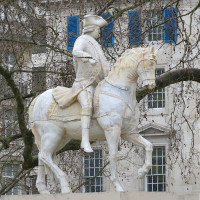
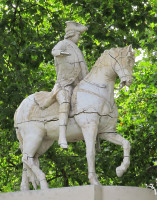
From time to time, I have gone back to look at this intriguing work, and find it rather sad that it is, as planned, gradually decaying. The two pictures above show how it looked in May 2013, and then again in October. The month of May found cracks opening along the body, across the arms, and the head of the horse, perhaps reflecting the extra tension in the soap when there was no direct support from underneath. By October, the cracks are bigger and the arm is gone, revealing the armature; the opposing leg on the other side likewise fell off. The statue has lasted longer than anticipated, which was to have been for the year to June. Is there no way that the powers that be can find the imagination to have a permanent statue in the centre of the Square, nicely historical in spirit?
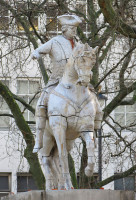
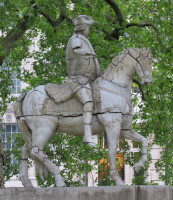 Duke of Cumberland soap statue still in place, though increasingly decaying - Jan 2014, and May 2014.
Duke of Cumberland soap statue still in place, though increasingly decaying - Jan 2014, and May 2014.
This page was originally part of a 'sculpture of the month' series, for Nov.2014. Although the older pages in that series have been absorbed within the site, if you would wish to follow the original monthly series, then jump to the next month (Dec. 2012) or the previous month (October 2012). To continue, go to the bottom of each page where a paragraph like this one allows you to continue to follow the monthly links.
Sculptors // Cavendish Square // Sculpture in London
Visits to this page from 13 Mar 2014: 12,142